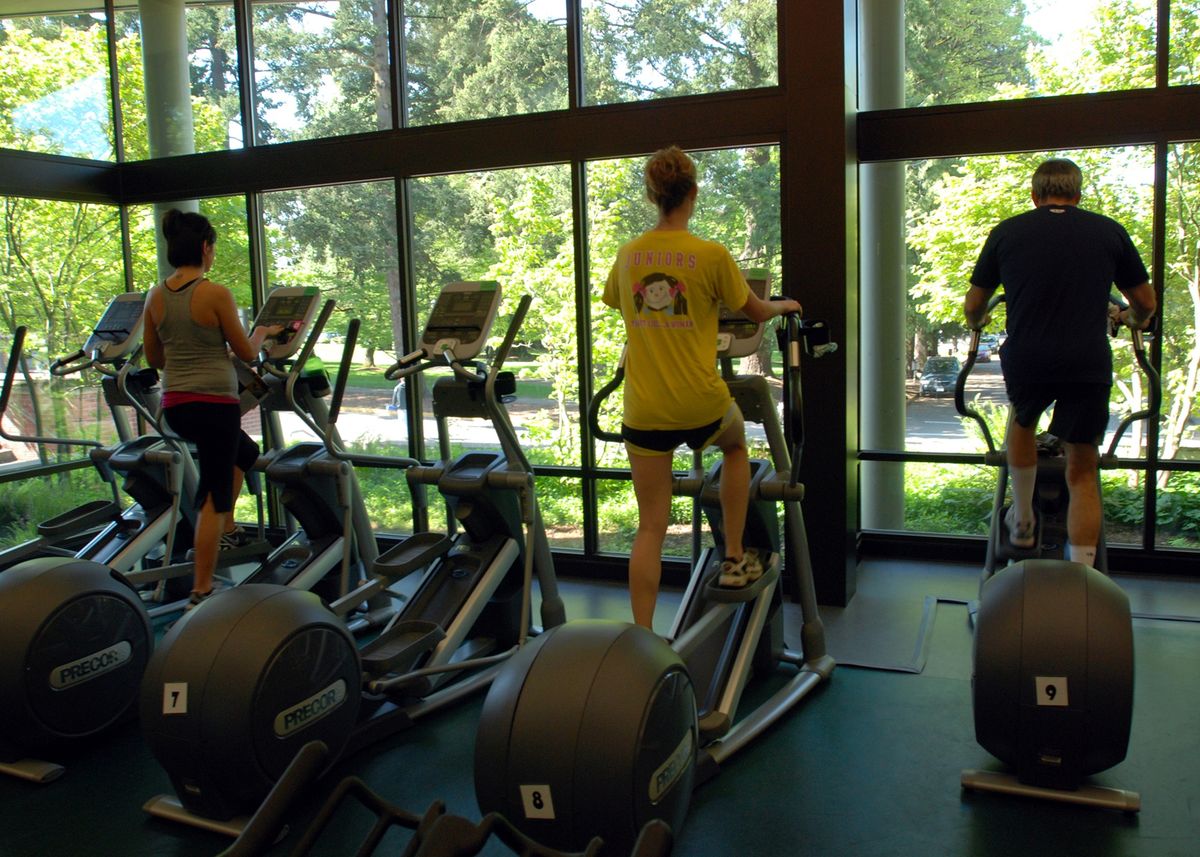University’s gym a power generator
Oregon students work out for watts

EUGENE, Ore. – As she pedaled an elliptical exercise machine at the University of Oregon, Wen Lee’s face lit up like the light bulbs she was powering.
“I could run my television with this,” the environmental studies graduate student said between breaths, making the three bulbs on the stand in front of her glow brighter as part of a demonstration of renewable people power.
The University of Oregon – one of its school colors is, after all, green – is the latest in a growing number of college campuses and exercise clubs across the country to turn workouts into watts.
Splitting the $14,000 cost with the local utility, Eugene Water and Electric Board, the school has retrofitted 20 Precor elliptical machines to produce electricity with ReCardio technology produced by ReRev.com of St. Petersburg, Fla. The power from each machine in the Student Recreation Center goes through a converter that turns DC into AC, and a meter to keep track before it flows into the grid.
The amount of power produced is small. The university estimates that 3,000 people a day on 20 machines will produce 6,000 kilowatt hours a year, enough to power a small energy-efficient house in the Northwest. But it fits in with other sustainability projects, such as solar panels on the rec center roof, and a high sense of being green among the student body.
“Oh, wow! It’s awesome! That’s cool!” sophomore Eileen Donnerberg said when told the machine she had chosen for her workout was producing electricity. “I never thought of that. It’s a good thing.”
The machines are even making their way into the run-up to one of the school’s biggest events: the annual Civil War football game with Oregon State University. OSU connected 22 exercise machines to the grid last February and will compete with Oregon to see who can generate the most electricity.
The power is a drop in the bucket compared to the University of Oregon’s overall electricity consumption, which is equivalent to 2,280 houses, said sustainability director Steve Mital. Northwest power rates are so low it would take 28 years to recoup the investment, but Mital said that isn’t really the point.
“We’re not going to get off Middle Eastern oil by connecting up all the ellipticals all over the country,” said Mital. “We bought it and installed it mostly because it’s an educational opportunity. People will be on those things sweating away, and it gets them thinking.”
Oregon decided to take the plunge at the suggestion of students, who were inspired by a demonstration of exercise bikes charging batteries at last year’s Olympic track and field trials held here.
“So much of this talk about renewables is fairly abstract,” said Mital. “You jump on one of these machines and 30 minutes later you have a deep visceral understanding of what that means. That’s what I’m after, primarily.”
ReRev.com stands for Renewable Revolution and was started by Hudson Harr, 23, soon after he graduated from the University of Florida, which was an early adopter.
After pulling the guts out of a variety of exercise machines, from bikes to stair steppers, Harr found that the Precor elliptical already had a small generator in it to power the control panel and make the resistance. Most other brands and devices use alternators, which are better suited to charging batteries, the way they do in a car.
Harr’s outfit figured out a way to replace the resistors that eat up the excess power generated, and instead send it to the power grid. He has a patent pending.
ReRev.com estimates a typical 30-minute workout on one machine makes enough power to run a laptop computer for an hour, or a compact fluorescent light bulb for 2 1/2 hours.
Ten facilities are using the technology, and Harr said he hopes it spreads further as other manufacturers switch to generators instead of alternators.
“There are over 30,000 health clubs in the U.S.,” said Harr. “If you could figure each one producing electricity will take one house off the grid, that is 30,000 houses off the grid.”
Precor is cooperating with ReRev.com, but the terms of their agreement remain confidential, said Jim Birrell, chief innovation officer for the company, based in Woodinville, Wash.
“At this point, we are evaluating it, watching it and staying in touch with Hudson, but that’s about the extent of it at this point,” he said.
So is Adam Boesel, owner of the Green Microgym in the hip Alberta Arts District of Portland, which has a variety of exercise machines charging batteries with other systems. He figures affordability will determine how widespread it becomes.
“I really liken it to electric cars,” he said. “Seven or eight years ago, people were skeptical about whether it would become commonplace, and now it has.”